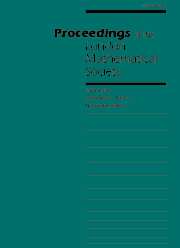Crossref Citations
This article has been cited by the following publications. This list is generated based on data provided by
Crossref.
Peterzil, Ya’acov
Pillay, Anand
and
Starchenko, Sergei
2000.
Simple algebraic and semialgebraic groups over real closed fields.
Transactions of the American Mathematical Society,
Vol. 352,
Issue. 10,
p.
4421.
Peterzil, Y.
Pillay, A.
and
Starchenko, S.
2000.
Definably simple groups in o-minimal structures.
Transactions of the American Mathematical Society,
Vol. 352,
Issue. 10,
p.
4397.
Buss, Samuel R.
Kechris, Alexander S.
Pillay, Anand
and
Shore, Richard A.
2001.
The Prospects for Mathematical Logic in the Twenty-First Century.
Bulletin of Symbolic Logic,
Vol. 7,
Issue. 2,
p.
169.
Edmundo, Mário J.
2003.
Solvable groups definable in o-minimal structures.
Journal of Pure and Applied Algebra,
Vol. 185,
Issue. 1-3,
p.
103.
Miller, Chris
and
Tyne, James
2006.
Expansions of o-Minimal Structures by Iteration Sequences.
Notre Dame Journal of Formal Logic,
Vol. 47,
Issue. 1,
Edmundo, Mário J.
2006.
Locally definable groups in o-minimal structures.
Journal of Algebra,
Vol. 301,
Issue. 1,
p.
194.
Hrushovski, Ehud
and
Peterzil, Ya'acov
2007.
A question of van den Dries and a theorem of Lipshitz and Robinson; Not everything is standard.
Journal of Symbolic Logic,
Vol. 72,
Issue. 1,
p.
119.
Maalouf, Fares
2008.
Construction d'un groupe dans les structures C-minimales.
Journal of Symbolic Logic,
Vol. 73,
Issue. 3,
p.
957.
Dolich, Alfred
Miller, Chris
and
Steinhorn, Charles
2009.
Structures having o-minimal open core.
Transactions of the American Mathematical Society,
Vol. 362,
Issue. 3,
p.
1371.
YONEDA, Ikuo
2009.
Some remarks on CM-triviality.
Journal of the Mathematical Society of Japan,
Vol. 61,
Issue. 2,
Arai, Toshiyasu
2009.
10th Asian Logic Conference.
The Bulletin of Symbolic Logic,
Vol. 15,
Issue. 2,
p.
246.
Peterzil, Ya'Acov
2009.
Returning to semi-bounded sets.
The Journal of Symbolic Logic,
Vol. 74,
Issue. 2,
p.
597.
Ramakrishnan, Janak
2010.
Uniform bounds on growth in o‐minimal structures.
Mathematical Logic Quarterly,
Vol. 56,
Issue. 4,
p.
406.
Hasson, Assaf
and
Onshuus, Alf
2010.
Unstable structures definable in o-minimal theories.
Selecta Mathematica,
Vol. 16,
Issue. 1,
p.
121.
Andrews, Simon
2010.
Definable Open Sets As Finite Unions of Definable Open Cells.
Notre Dame Journal of Formal Logic,
Vol. 51,
Issue. 2,
Hasson, Assaf
Onshuus, Alf
and
Peterzil, Ya’acov
2010.
Definable one dimensional structures in o-minimal theories.
Israel Journal of Mathematics,
Vol. 179,
Issue. 1,
p.
297.
Hasson, Assaf
Onshuus, Alf
and
Peterzil, Ya’acov
2010.
Definable structures in o-minimal theories: One dimensional types.
Israel Journal of Mathematics,
Vol. 179,
Issue. 1,
p.
363.
Penazzi, Davide
2011.
One-basedness and groups of the form G/G 00.
Archive for Mathematical Logic,
Vol. 50,
Issue. 7-8,
p.
743.
Eleftheriou, Pantelis E.
and
Peterzil, Ya’acov
2012.
Definable groups as homomorphic images of semi-linear and field-definable groups.
Selecta Mathematica,
Vol. 18,
Issue. 4,
p.
905.
Eleftheriou, Pantelis E.
and
Peterzil, Ya’acov
2012.
Definable quotients of locally definable groups.
Selecta Mathematica,
Vol. 18,
Issue. 4,
p.
885.

